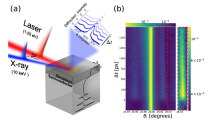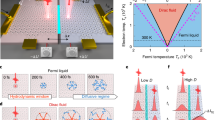Abstract
In nanoscale semiconductor devices, not only do electron–electron interactions require proper treatment but heat transport must also be integrated coherently. In this Perspective, we propose a paradigm shift: to treat electron transport using a three-part phase diagram that includes diffusive, ballistic and viscous electron-fluid regimes and to adopt a statistical-field approach to extend the tools for analysis, including the drift–diffusion model. The statistical-field approach posits that semiconductor devices — as open quantum systems characterized by fluctuating energy and particle numbers — can achieve local equilibrium through frequent microscopic collisions of electrons. The corresponding statistical fields emerge — specifically, spatial and temporal variations in temperature and chemical potential, which dictate the flows of energy and particles. The quantum nature of these statistical fields enables a seamless integration of quantum complexities, and the approach naturally incorporates heat dissipation in a self-consistent theoretical framework (although the proper modelling of boundary conditions requires further attention). We highlight the critical need to identify the transport regime in which short-channel nanodevices operate, to be able to build accurate simulators that will drive device design and optimization.
This is a preview of subscription content, access via your institution
Access options
Subscribe to this journal
Receive 12 digital issues and online access to articles
$119.00 per year
only $9.92 per issue
Buy this article
- Purchase on SpringerLink
- Instant access to full article PDF
Prices may be subject to local taxes which are calculated during checkout


Similar content being viewed by others
References
Mistry, K. et al. A 2.0 V, 0.35 μm partially depleted SOI-CMOS technology. In IEEE International Electron Devices Meeting 583–586 (IEEE, 1997).
Tenbroek, B. et al. Self-heating effects in SOI MOSFETs and their measurement by small signal conductance techniques. IEEE Trans. Electron Devices 43, 2240–2248 (1996).
Ghani, T. et al. A 90 nm high volume manufacturing logic technology featuring novel 45 nm gate length strained silicon CMOS transistors. In IEEE International Electron Devices Meeting 978–980 (IEEE, 2003).
Mistry, K. et al. A 45 nm logic technology with high-k + metal gate transistors, strained silicon, 9 Cu interconnect layers, 193 nm dry patterning, and 100% Pb-free packaging. In IEEE International Electron Devices Meeting 247–250 (IEEE, 2007).
Auth, C. et al. A 22 nm high performance and low-power CMOS technology featuring fully-depleted tri-gate transistors, self-aligned contacts and high density MIM capacitors. In IEEE VLSI Technology Symposium 131–132 (IEEE, 2012).
Bohr, M., Chau, R., Ghani, T. & Mistry, K. The high-k solution. IEEE Spectr. 44, 29–35 (2007).
Kuhn, K. J. Considerations for ultimate CMOS scaling. IEEE Trans. Electron Devices 59, 1813–1828 (2012).
Cao, W. et al. The future transistors. Nature 620, 501 (2023).
Koba, S. et al. Channel length scaling limits of III–V channel MOSFETs governed by source–drain direct tunneling. Jpn. J. Appl. Phys. 53, 04EC10 (2014).
Jin, D., Kim, D., Kim, T. & del Alamo, J. A. Quantum capacitance in scaled down III–V FETs. In IEEE International Electron Devices Meeting 495–498 (IEEE, 2009).
Skotnicki, T. & Boeuf, F. How can high mobility channel materials boost or degrade performance in advanced CMOS. In IEEE VLSI Technology Symposium 153–154 (IEEE, 2010).
Rasouli, S., Dadgour, H., Endo, K., Koike, H. & Banerjee, K. Design optimization of FinFET domino logic considering the width quantization property. IEEE Trans. Electron Devices 57, 2934–2943 (2010).
Mizutani, T. et al. Threshold voltage and current variability of extremely narrow silicon nanowire MOSFETs with width down to 2 nm. In Silicon Nanoelectronics Workshop (IEEE, 2015).
Yu, B., Wann, C., Nowak, E. D., Noda, K. & Hu, C. Short-channel effect improved by lateral channel-engineering in deep-submicronmeter MOSFETs. IEEE Trans. Electron Devices 44, 627–634 (1997).
Liao, S. et al. Complementary field-effect transistor (CFET) demonstration at 48 nm gate pitch for future logic technology scaling. In 2023 International Electron Devices Meeting (IEDM) 1–4 (2023).
Taur, Y. & Ning, T. H. Fundamentals of Modern VLSI Devices (Cambridge Univ. Press, 2022).
SentaurusTM Device User Guide, Version K-2015.06, Synopsys, Inc. (2015).
Varnavides, G., Yacoby, A., Felser, C. & Narang, P. Charge transport and hydrodynamics in materials. Nat. Rev. Mater. 8, 726–741 (2023).
Sulpizio, J. A. et al. Visualizing Poiseuille flow of hydrodynamic electrons. Nature 576, 75–79 (2019).
Kittel, C. & Kroemer, H. Thermal Physics (W. H. Freeman and Company, 1980).
Pathria, R. K. & Beale, P. D. Statistical Mechanics (Elsevier Ltd, 2011).
Peliti, L. Statistical Mechanics in a Nutshell (Princeton Univ. Press, 2011).
Sabbah, A. J. & Riffe, D. M. Femtosecond pump–probe reflectivity study of silicon carrier dynamics. Phys. Rev. B 66, 165217 (2002).
Martin Wörle, M., Holleitner, A. W., Reinhard Kienberger, R. & Iglev, H. Ultrafast hot-carrier relaxation in silicon monitored by phase-resolved transient absorption spectroscopy. Phys. Rev. B 104, L041201 (2021).
Keser, A. C. et al. Geometric control of universal hydrodynamic flow in a two-dimensional electron fluid. Phys. Rev. X 11, 031030 (2021).
Krebs, Z. J. et al. Imaging the breaking of electrostatic dams in graphene for ballistic and viscous fluids. Science 379, 671–676 (2023).
Bandurin, D. A. et al. Negative local resistance caused by viscous electron backflow in graphene. Science 351, 1055–1058 (2016).
Krishna Kumar, R. et al. Superballistic flow of viscous electron fluid through graphene constrictions. Nat. Phys. 13, 1182–1185 (2017).
Polini, M. & Geim, A. K. Viscous electron fluids. Phys. Today 6, 28–34 (2020).
Estrada-Álvarez, J., Domínguez-Adame, F. & Díaz, E. Alternative routes to electron hydrodynamics. Commun. Phys. 7, 138 (2024).
Pusep, Y. A. et al. Diffusion of photoexcited holes in a viscous electron fluid. Phys. Rev. Lett. 128, 136801 (2022).
Lee, T. D. & Yang, C. N. Many-body problem in quantum mechanics and quantum statistical mechanics. Phys. Rev. 105, 1119 (1957).
Lee, T. D. & Yang, C. N. Many-body problem in quantum statistical mechanics. II. Virial expansion hard-sphere gas. Phys. Rev. 116, 25 (1959).
Weng et al. Quasiadiabatic electron transport in room temperature nanoelectronic devices induced by hot-phonon bottleneck. Nat. Commun. 12, 4752 (2021).
Xue, H. et al. Direct observation of hot-electron-enhanced thermoelectric effects in silicon nanodevices. Nat. Commun. 14, 3731 (2023).
Huang, Z. et al. Local ionic and electron heating in single-molecule junctions. Nat. Nanotechnol. 2, 698–703 (2007).
Yang, L., Qian, R. J., An, Z. H., Komiyama, S. & Lu, W. Simulation of temperature profile for the electron and the lattice systems in laterally structured layered conductors. epl 128, 17001 (2019).
Onsager, L. Reciprocal relations in irreversible processes. I. Phys. Rev. 37, 405 (1931).
Hankiewicz, E. M. et al. Charge Hall effect driven by spin-dependent chemical potential gradients and onsager relations in mesoscopic systems. Phys. Rev. B 72, 155305 (2005).
Gorini, C., Raimondi, R. & Schwab, P. Onsager relations in a two-dimensional electron gas with spin–orbit coupling. Phys. Rev. Lett. 109, 246604 (2012).
Luo, R., Benenti, G., Casati, G. & Wang, J. Onsager reciprocal relations with broken time-reversal symmetry. Phys. Rev. Res. 2, 022009(R) (2020).
Kiselev, E. I. & Schmalian, J. Boundary conditions of viscous electron flow. Phys. Rev. B 99, 035430 (2019).
Di Ventra, M. Electrical Transport in Nanoscale Systems (Cambridge Univ. Press, 2008).
Stern, A. et al. How electron hydrodynamics can eliminate the Landauer–Sharvin resistance. Phys. Rev. Lett. 129, 157701 (2022).
Li, S., Levchenko, A. & Andreev, A. V. Hydrodynamic thermoelectric transport in Corbino geometry. Phys. Rev. B 105, 125302 (2022).
Acknowledgements
The authors acknowledge fruitful discussions with I.F. Hu, W.-Y. Woon, L. Yang and W.-X. You. H.-H.L. acknowledges supports from National Science and Technology Council (Taiwan) through grant NSTC-113-2112-M-007-017 and from Taiwan Semiconductor Manufacturing Company through University Joint Development Project TUP-20231011-3510.
Author information
Authors and Affiliations
Contributions
H.-H.L. and S.S.L. proposed and supervised the project. Y.-C.Y. and H.-H.L. performed the theoretical calculations. All authors contributed to discussions and the writing of the manuscript.
Corresponding authors
Ethics declarations
Competing interests
The authors declare no competing financial interests.
Peer review
Peer review information
Nature Reviews Electrical Engineering thanks Zhenghua An and the other, anonymous, reviewer(s) for their contribution to the peer review of this work.
Additional information
Publisher’s note Springer Nature remains neutral with regard to jurisdictional claims in published maps and institutional affiliations.
Rights and permissions
Springer Nature or its licensor (e.g. a society or other partner) holds exclusive rights to this article under a publishing agreement with the author(s) or other rightsholder(s); author self-archiving of the accepted manuscript version of this article is solely governed by the terms of such publishing agreement and applicable law.
About this article
Cite this article
Yang, YC., Lin, HH. & Liao, S.S. A statistical-field approach to electron transport in semiconductor nanodevices. Nat Rev Electr Eng 2, 614–620 (2025). https://doi.org/10.1038/s44287-025-00192-4
Accepted:
Published:
Issue date:
DOI: https://doi.org/10.1038/s44287-025-00192-4



